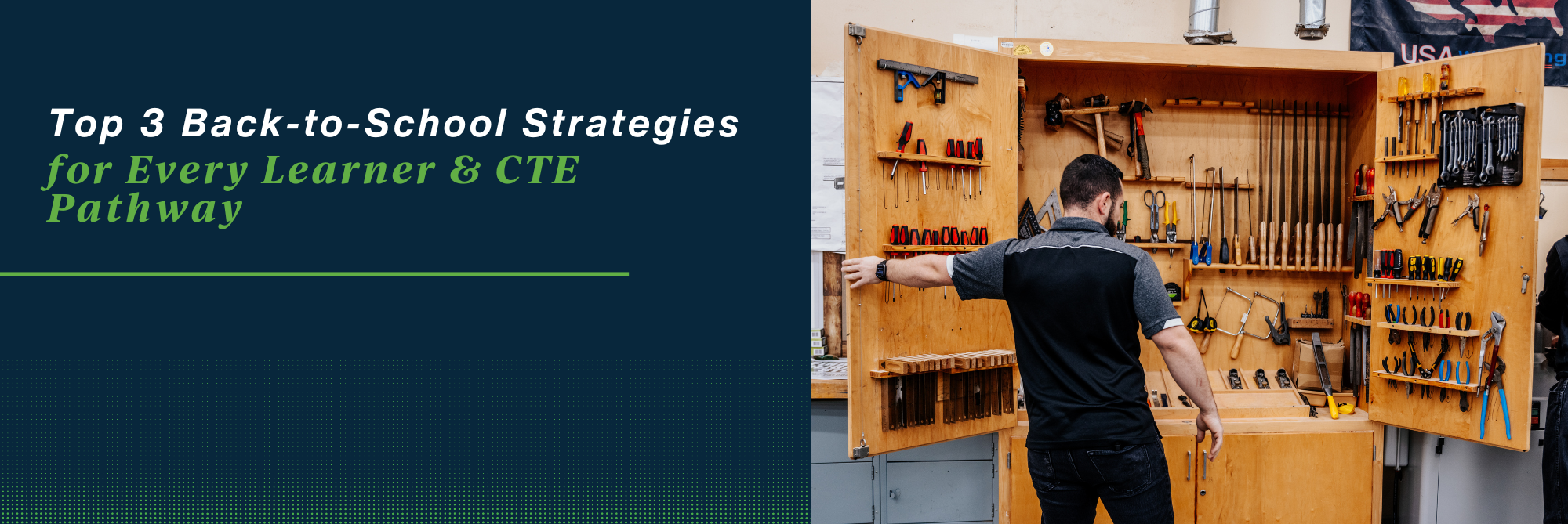Teaching Strategies | Back to School
Top 3 Back-to-School Strategies for Every Learner & CTE Pathway
Annie, a Customer Engagement Manager, is a former CTE teacher with a background in agricultural science and Floral Design. She earned her bachelor’s degree from Tarleton State University and her master’s degree from Texas A&M University–Commerce. Annie draws on her classroom experience to connect with teachers and administrators, provide meaningful training, and ensure CTE educators and students are equipped for success with iCEV.
Today, starting the school year strong as a CTE educator is about more than just checking boxes—it’s about creating an engaging, inclusive environment where every student can succeed.
But let’s be honest: terms like “inclusive” and “engaging environment” can start to feel like buzzwords if they’re not paired with real strategies.
As part of our 2025 Back to School Virtual PD Series, our CTE experts explored three practical strategies to set your course up for success, reach every learner, and make accessibility a strength. In this article, we’ll explore:
- Setting Your CTE Course Up for Success Beyond the Basics
- Differentiated Instruction Strategies for Every Learner
- Accessibility Tools Built to Unlock Opportunity in CTE Classrooms
These aren’t just ideas in an article—they’re actionable steps you can take from day one to make your classroom inclusive, engaging, and ready for every student to thrive.
1.) Setting Your CTE Course Up for Success Beyond the Basics
A new school year brings both opportunities and challenges. While supplies and lesson plans matter, true success comes from building community, personalizing instruction, and setting up systems that keep learning on track.
Building a Strong Classroom Community
Establishing class norms and expectations early on sets the tone for respect, collaboration, and accountability. When students understand what’s expected of them, they can focus more on learning and less on navigating uncertainty.
To strengthen these connections, consider incorporating strategies such as those from the lead4ward instructional strategies playlists during the first weeks of school. These strategies can serve as icebreakers and continue to be used throughout the year to spark student engagement, promote meaningful interaction, and provide teachers with insight into student understanding.
Customizing Lesson Plans for Every Learner
No two classrooms are exactly alike, which makes flexibility one of the most valuable teaching skills. While pre-made lesson plans provide a great starting point, teachers should adapt them to match their students’ unique needs.
This might mean adjusting pacing to ensure mastery, weaving in supplemental resources, or modifying activities for different learning styles and ability levels.
Explore 6 Top Customization Options to Enhance Your iCEV Experience including creating custom courses, assessments and more designed to meet every learner's needs in your classroom.
2.) Differentiated Instruction Strategies for Every Learner
No two students learn the same way—some need visuals, others discussion, and many hands-on practice. With diverse needs and readiness levels, today’s classrooms demand flexibility.
Looking for differentiation strategies for special populations students? Download your FREE Teaching Strategies for Special Populations Guide to gain instant access to actionable strategies to help all students find success in your CTE classroom.
Ways to Differentiate Instruction with iCEV
Differentiation isn’t just an educational trend—it’s an essential part of teaching. CTE teachers in particular work with students who bring a wide spectrum of abilities, interests, and readiness levels.
The key is building flexibility into lesson design, and iCEV supports educators in this by providing:
- Multi-modal content: Present information visually, verbally, and kinesthetically so students can access it from different angles.
- Flexible grouping & tiered assignments: Allow students to move at their own pace while keeping expectations high.
- Instant feedback & data insights: Quickly identify who needs extra support or who is ready for enrichment.
By planning with flexibility in mind, teachers can reach more learners without watering down rigor.
3.) Accessibility Tools Built to Unlock Opportunity in CTE Classrooms
To ensure all students succeed, accessibility must be built into the learning experience. Students with disabilities or language barriers need tools that make content clear and personalized.
Key accessibility supports iCEV offers include:
- Screen reader compatibility & closed captioning to strengthen comprehension.
- Translation & text-to-speech functions to eliminate language barriers.
- Adjustable visual settings (font size, contrast, color options) to improve comfort and clarity.
When accessibility is embedded into classroom resources, students gain confidence, independence, and ownership of their learning.
View iCEV’s Commitment to Accessibility including assistive technology compatibility and content delivery.
Building the Foundation for a Strong Year
By building community, tailoring lessons, and embedding accessibility, CTE educators create classrooms where every student can thrive.
With the right strategies and tools, supporting diverse learners doesn’t have to feel overwhelming. Instead, it becomes an opportunity to empower students, highlight their unique strengths, and prepare them for meaningful career pathways.
If you’d like to dive deeper into these strategies—or explore how iCEV can help set your CTE classroom up for success this school year, our dedicated CTE Customer Support are here to help. Contact our team using the button below to set you and your students on a path for success.


